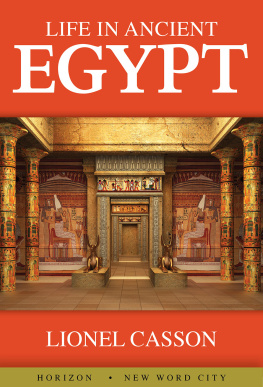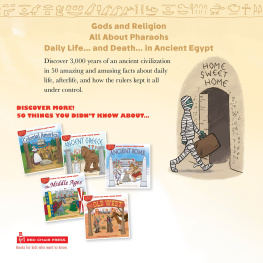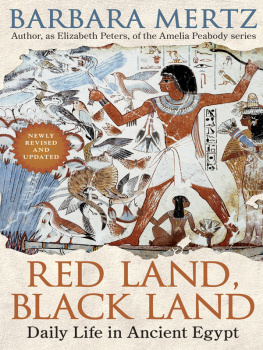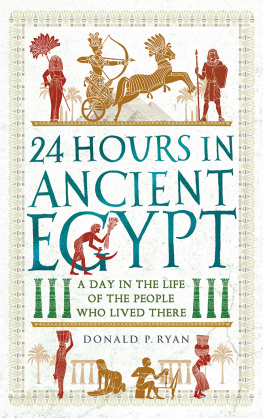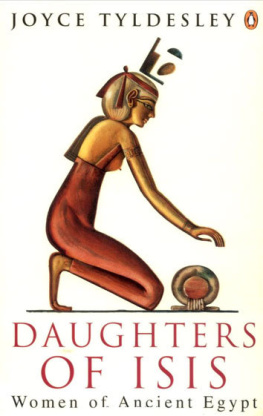Lisa K. Sabbahy - Daily Life of Women in Ancient Egypt
Here you can read online Lisa K. Sabbahy - Daily Life of Women in Ancient Egypt full text of the book (entire story) in english for free. Download pdf and epub, get meaning, cover and reviews about this ebook. year: 2022, publisher: ABC-CLIO, genre: Children. Description of the work, (preface) as well as reviews are available. Best literature library LitArk.com created for fans of good reading and offers a wide selection of genres:
Romance novel
Science fiction
Adventure
Detective
Science
History
Home and family
Prose
Art
Politics
Computer
Non-fiction
Religion
Business
Children
Humor
Choose a favorite category and find really read worthwhile books. Enjoy immersion in the world of imagination, feel the emotions of the characters or learn something new for yourself, make an fascinating discovery.
- Book:Daily Life of Women in Ancient Egypt
- Author:
- Publisher:ABC-CLIO
- Genre:
- Year:2022
- Rating:4 / 5
- Favourites:Add to favourites
- Your mark:
- 80
- 1
- 2
- 3
- 4
- 5
Daily Life of Women in Ancient Egypt: summary, description and annotation
We offer to read an annotation, description, summary or preface (depends on what the author of the book "Daily Life of Women in Ancient Egypt" wrote himself). If you haven't found the necessary information about the book — write in the comments, we will try to find it.
Daily Life of Women in Ancient Egypt — read online for free the complete book (whole text) full work
Below is the text of the book, divided by pages. System saving the place of the last page read, allows you to conveniently read the book "Daily Life of Women in Ancient Egypt" online for free, without having to search again every time where you left off. Put a bookmark, and you can go to the page where you finished reading at any time.
Font size:
Interval:
Bookmark:

Recent Titles in
The Greenwood Press Daily Life Through History Series
Arthurian Britain
Deborah J. Shepherd
Victorian Women
Lydia Murdoch
The California Gold Rush
Thomas Maxwell-Long
18th-Century England, Second Edition
Kirstin Olsen
Colonial New England, Second Edition
Claudia Durst Johnson
Life in 1950s America
Nancy Hendricks
Jazz Age America
Steven L. Piott
Women in the Progressive Era
Kirstin Olsen
The Industrial United States, 18701900, Second Edition
Julie Husband and Jim OLoughlin
The 1960s Counterculture
Jim Willis
Renaissance Italy, Second Edition
Elizabeth S. Cohen and Thomas V. Cohen
Nazi-Occupied Europe
Harold J. Goldberg
African American Slaves in the Antebellum
Paul E. Teed and Melissa Ladd Teed
Women in Postwar America
Nancy Hendricks
LISA K. SABBAHY
The Greenwood Press Daily Life Through History Series

Copyright 2022 by ABC-CLIO, LLC
All rights reserved. No part of this publication may be reproduced, stored in a retrieval system, or transmitted, in any form or by any means, electronic, mechanical, photocopying, recording, or otherwise, except for the inclusion of brief quotations in a review, without prior permission in writing from the publisher.
Library of Congress Cataloging-in-Publication Data
Names: Sabbahy, Lisa, author.
Title: Daily life of women in ancient Egypt / Lisa K. Sabbahy.
Description: Santa Barbara, California : Greenwood, [2022] | Series: The Greenwood Press daily life through history series | Includes bibliographical references and index.
Identifiers: LCCN 2021032128 (print) | LCCN 2021032129 (ebook) | ISBN 9781440870132 (hardcover) | ISBN 9781440870149 (ebook)
Subjects: LCSH: WomenEgyptHistory. | WomenEgyptSocial conditions. | WomenHistoryTo 500. | EgyptCivilization To 332 B.C. | EgyptHistoryTo 332 B.C.
Classification: LCC HQ1137.E3 S23 2022 (print) | LCC HQ1137.E3 (ebook) | DDC 305.40962dc23
LC record available at https://lccn.loc.gov/2021032128
LC ebook record available at https://lccn.loc.gov/2021032129
ISBN: 978-1-4408-7013-2 (print)
978-1-4408-7014-9 (ebook)
26 25 24 23 221 2 3 4 5
This book is also available as an eBook.
Greenwood
An Imprint of ABC-CLIO, LLC
ABC-CLIO, LLC
147 Castilian Drive
Santa Barbara, California 93117
www.abc-clio.com
This book is printed on acid-free paper 
Manufactured in the United States of America
Our modern knowledge of ancient Egyptian civilization has been greatly helped by the fact that the hot, dry climate of Egypt has preserved many objects and written documents. Also, because temples and tombs were built to last for eternity, they were constructed out of stone blocks, and as a result, many of themalthough damagedstill stand. That said, temples and tombs reflect the state and the royal rulers and elite officials who built them. On the walls of these structures are carved and painted scenes that present a perfect, everlasting picture of the king and his land. Such idealized pictures hardly represent everyday life in ancient Egypt. It has to be pointed out that royalty and the elite made up a very small tip of the enormous pyramid of ancient Egyptian society, and because the king and his officials were all male, their view of life would only represent 50% of ancient Egypt anyway.
The study of Egyptology is heavily based on documents, of which many remain, not only on papyrus but also inscribed on the walls of temples and tombs. From what is known of the ancient Egyptian educational system, all schooling was for boys, to train them to be scribes and to grow up and work for the state. This discussion may seem like a digression on masculine domination in ancient Egypt, but it is important to understand why there should be a book on the daily life of women in ancient Egypt and why it is so difficult to actually write a book like that.
Around the 1980s, when archaeologists in general realized that the understanding of the past was primarily based on a male past, the reaction of some to make up for the lack of a holistic approach to ancient societies was put in a woman and stir. Hopefully, this approach will not appear in this book, although it is difficult to avoid it. Many topics such as kingship, the military, and administrative structure may seem to have been left out, but if a topic did not include women or there was no information relevant about women in it, it was not included in this book. That said, the author does provide substantially more information about elite women than non-elite women, but there was no real way to escape that. Elite and royal women had titles inscribed on stone monuments and had stone-built tombs or space in their husbands tombs, so scholars simply have more evidence about them. It must be pointed out, however, that this evidence may not reflect daily life, but again, eternal life in the afterlife.
A typical village woman would have worked hard, possibly suffered horribly in childbirth, cooked, cleaned, and raised children. When she died, at the age of twenty-five to thirty years, she would have been buried in a pit dug in the village cemetery, perhaps wrapped in a reed bundle with a bead necklace and possibly a small amulet or a vessel or two of food or drink. An archaeologist finding her burial would note the few objects present and how they compare to others in similar and contemporary cemeteries. The osteologist who studies her skeleton might note the skeletal changes in her toes, knees, and some of the vertebrae and conclude that she spent time grinding grain for bread and beer. A healed fracture of her left arm shows that someone in the village was a healer and put a proper splint on her arm. Her teeth would be worn down and several lost, which is to be expected when one eats bread that sand gets into. In other words, this woman was a very typical lower-class or lower-middle-class housewife, but what else can we learn about her? What about her dreams, thoughts, and likes or dislikes? What was her daily routine like? Very little about a typical womans life in ancient Egypt can be figured out, especially from the perspective of a modern mind deciding how an ancient person thought. These gaps in our knowledge are the reason why evidence from texts and artistic depictions, which are products of a mostly elite life, have to be depended on for information.
This book is broken into seven chapters, the topics of which often overlap. For example, discussing a priestess belongs in the chapter on religion, but as she is also paid for what she does as a priestess, the topic appears in the chapter on work as well. Each chapter starts out with a brief historical fiction paragraph based on ancient evidence, and at the end of select chapters, there is a short translation of a primary source to give readers an idea about how ancient Egyptians presented themselves.
on Personal Property covers a range of topics, including houses, furniture, cooking, cosmetics, clothing, and pets.
, Religious Life and the Afterlife, examines expressions of religiosity in daily life, important goddesses, the concept of the afterlife, mummification, the funeral, the tomb, ancestral cults, and the wise woman.
Font size:
Interval:
Bookmark:
Similar books «Daily Life of Women in Ancient Egypt»
Look at similar books to Daily Life of Women in Ancient Egypt. We have selected literature similar in name and meaning in the hope of providing readers with more options to find new, interesting, not yet read works.
Discussion, reviews of the book Daily Life of Women in Ancient Egypt and just readers' own opinions. Leave your comments, write what you think about the work, its meaning or the main characters. Specify what exactly you liked and what you didn't like, and why you think so.



